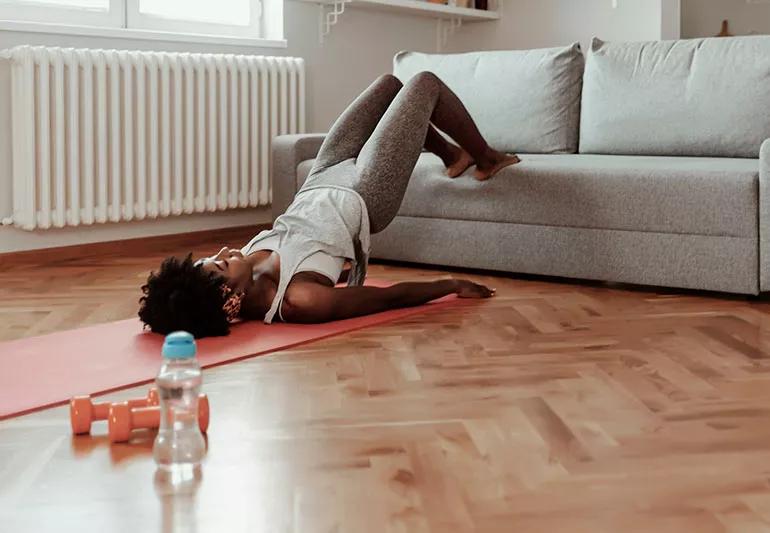How to bounce back when a gymnastics injury has sidelined you

Tens of thousands of athletes visit the emergency room each year because of gymnastics injuries. Sports medicine specialist Marie Schaefer, MD, explains how gymnasts can make the most of their recovery and get back on the mat sooner.
Advertisement
Cleveland Clinic is a non-profit academic medical center. Advertising on our site helps support our mission. We do not endorse non-Cleveland Clinic products or services. Policy
Many hard-core gymnasts try to minimize their injuries or ignore them. But Dr. Schaefer recommends the opposite approach if you want to get back to your sport.
“Treat injuries aggressively and quickly,” says Dr. Schaefer. “Resting or immobilizing an injury with a brace allows it to heal quickly. Don’t try to play through the injury — you’ll just prolong your recovery and delay your return.”
The RICE method — rest, ice, compression and elevation — is a helpful tool to use. “Ice is a strong anti-inflammatory and is important to use after injuries,” says Dr. Schaefer.
When it’s time to ease back into activity, work with a physical therapist (PT) or athletic trainer specializing in caring for gymnasts. A specialist can help you get back into the sport without aggravating the injury or getting hurt again.
“Early physical therapy is important for gymnasts,” explains Dr. Schaefer. “Your therapist can guide you through exercises that are safe to do as you heal. They can show you how to do modified routines that won’t put weight or strain on your injured body part.”
Find ways to keep up your fitness level while you heal without doing gymnastics. If you have an injured wrist, focus on running, work on core exercises or practice lower-body resistance. If you’ve injured your lower body, concentrate on core exercises and building upper body strength.
Advertisement
A swimming pool can be useful as you recover. Swimming or water aerobics offer resistance and cardio options with less impact on your joints.
Check in with your PT or trainer as you recover to make sure the injury is healing well. Wait to return to the mats until you get cleared by your doctor or therapist. Even after you go back, expect your routine to look different for a while.
“Return to gymnastics in steps,” says Dr. Schaefer. “Injured gymnasts should start at about 25% of their previous skill level. For example, a level 8 gymnast should begin at a level 2 skill after an injury.”
If you’re performing the lower-level skill without pain, you can take it up a notch the next day. “Only do one new activity per day,” says Dr. Schaefer. “That way, you can see how you feel the next morning. If you have any pain, you’ll know what caused it, and you can address it with your PT or trainer.”
You might be sore after trying a new activity because you haven’t used those muscles in a while. Don’t ignore pain. Tell your doctor, PT or trainer about it.
“A small amount of soreness might be acceptable, but it depends on the injury,” says Dr. Schaefer. “That’s why you need to talk to your provider and find out whether it’s normal or whether you need to back off.”
Gymnasts may be disappointed or even devastated by an injury that interrupts their sport. It can be tempting to isolate yourself after getting hurt — but don’t go it alone.
“Keep in touch with teammates, friends and coaches as you recover,” says Dr. Schaefer. “They can be a source of encouragement and support. Mental and emotional health are just as important as regaining your physical health.”
Finally, ask yourself if the love affair with gymnastics is still there. Maybe the passion and commitment are as strong as ever — or maybe you’re ready to move on.
This question is especially important when it comes to young gymnasts. “Sometimes, young athletes decide they want to try different sports or activities,” says Dr. Schaefer. “Meanwhile, their parents push them to continue because they think it’s best for their child.”
Check with your child regularly to see how they feel. Though it’s hard for parents to let go of something they’ve invested time, money and energy in, it may be the right move.
“I’ve talked to gymnasts who want to do other things, but they don’t want to let their parents down,” says Dr. Schaefer. “Give your child freedom to make choices about their activities and interests. Their passions may change as they grow, but that’s how they find out who they are.”
Advertisement
Advertisement
Learn more about our editorial process.
Advertisement

To avoid swimmer’s eye, wear goggles, use eye drops and flush out your eyes with fresh, clean water when irritated

Keep kids safe while they swim by staying vigilant and setting up a safe pool environment

Having a well-rounded, healthy nutrition plan is just as important as staying consistent with your exercise routine

Whether you’re cycling consistently or occasionally, it’s important to have safety essentials like a helmet, shirts with sleeves, eye protection and more

Concussion protocol describes the steps needed to test for concussion and return to play — timelines vary

The mental block is a brain-body disconnect that causes gymnasts to lose their sense of space on flips

A more open conversation on athletes and their mental health needs is overdue

You can reduce your risk by not swallowing water, and showering before and after swimming

Babies can get congested easily, but you can calm their cough by keeping them hydrated, using nasal drops and running a humidifier

Weight loss may cause loose, sagging skin and muscle loss to your rear

Several conditions, like vitiligo and fungal infection, can cause a loss of pigmentation, leading to white spots or patches on your skin